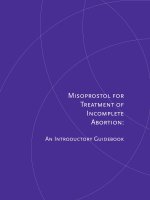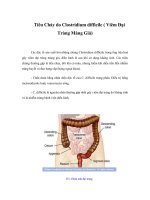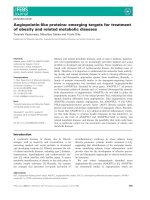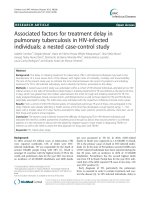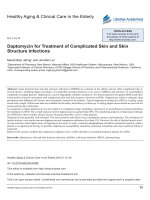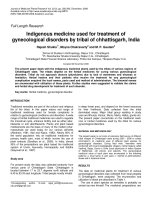Fecal microbiota transplantation for treatment recurrent clostridium difficile
Bạn đang xem bản rút gọn của tài liệu. Xem và tải ngay bản đầy đủ của tài liệu tại đây (7.82 MB, 23 trang )
Overview: Epidemiology, Microbiology, Pathogenesis,
Risk factors, Clinical spectrum, Treatment
Fecal microbiota transplantation ( FMT ) – Evidence
based medicine
Conclusion
References
Among children hospitalized at 22 United States
children’s hospitals, the incidence of C.difficile
infection increased by 53% from 2001 – 2006 ( 2.6 to
4.0 cases per 1000 admissions )
In 2011, incidence of C.difficile infection in children <
18 years was 24.2 cases per 100,000 population
Recurrence rates: 20 – 24%
C.difficile
Anaerobic
Gram positive
Spore – forming
Toxin – producing bacillus
Exist in spore form in the environment
Resistant to heat, acid, antibiotics and most disinfectants
Germinate to vegetative form and produce toxins
Alteration of the colonic microflora
Ingestion, colonization, and overgrowth of C.
difficile
Production of C. difficile toxin(s)
Injury to and inflammation of intestinal epithelium,
resulting in diarrhea
Antibiotic exposure: penicillins, cephalosporins,
clindamycin and flouroquinolones most frequently
implicated
Proton pump inhibitors
Gastrointestinal feeding devices ( gastrostomy,
jejunostomy tubes )
Immune compromise
Inflammatory bowel disease
Cystic fibrosis
Hirschsprung disease
Structural or postoperative intestinal disorders
Diarrhea
Pseudomembranous colitis
Fever
Prolonged watery diarrhea
Abdominal pain and distention
Blood or mucus in stool
Fulminant colitis
Toxic megacolon
Bowel perforation
Antibiotics
Metronidazole
Vancomycin
Fecal microbiota
transplantation
Patient 1:
20 months
Refractory RCDI of 8 months’ duration
Received cefdinir at 10 month for ear infection
Developed bloody diarrhea, feces test (+) for C.difficile
10 day course of metronidazole second course 2 week
oral vancomycin course
Weight less than 5th and length less than 3rd
3 months after FMT, weight increased to 50th and length reach
3rd
No CDI recurrence during 2 years follow up
Patient 2:
30 months
Developed upper respiratory infection requiring amoxicillin –
clavulanate and ciprofloxacin
Diarrhea (+) C.difficile
10 day course of metronidazole
3 courses of oral vancomycin
5 – month – pulse tapered vancomycin with probiotics
4 months after FMT, increase in weight to 84th
Journal of Pediatric Gastroenterology and Nutrition
Donors included 9 parents and 1 sibling
Median duration of follow up was 44 days
Median age was 5.4 years
9 patients ( 90% ) remained asymptomatic during
follow up
Lower GI route:
Colonoscopy
Flexible sigmoidoscopy
Rectal tube
Retention enema
Upper GI route:
Nasogastric tube
Nasointestinal tube
Gastroduodenoscopy
Recurrent C.difficile infection remains high ( 30% )
Efficacy of fecal microbiota transplantation was high
than antibiotics ( metronidazole, vancomycin ) 80% 90% compared to 30%
More RCTs are needed in pediatric patients

